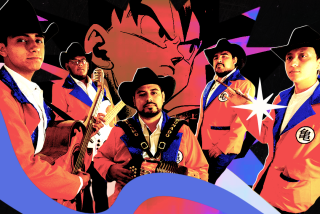Masks and Costumes Reflect Kagura Tradition
- Share via
Three enormous serpents snapping their jaws and uncoiling their tails the full width of the Japan America Theatre stage provided a spectacular climax to the first local performance by Hiroshima’s impressive, 10-member Hibakojin Kagura company on Saturday.
Portrayed by masked dancers wearing long, ribbed coils that resembled those on expanding paper lanterns, the serpents dominated the dance-drama “Yaegaki-no-noh” and emphasized the link to nature of a sacred idiom (originally performed at Shinto shrines) that dates back as far as the 3rd to 6th centuries.
In 1002, performances of kagura were instituted at the imperial court, and today many versions exist of what the Japanese government designated an “Important Intangible Folk Cultural Asset” in 1979.
The following year, the parent organization of Hibakojin Kagura was formed to preserve the distinctive traditions of the Hiba county area. The five-part program Saturday clothed those traditions in richly detailed costumes and masks, with forceful accompaniments supplied by drum, flute and cymbals, as well as expressive vocalism.
The evening included a demonstration of basic kagura movement (“Kyokumai”), a masked purification duet (“Sarudahiko-no-mai”) and a masked solo (“Daikokumai”) that not only heaped blessings on the spectators but tossed bags of rice cakes to them as a farewell offering.
Perhaps the most characteristic display of kagura artistry, however, came in the masked solo “Ebisu-no-mai.” Here, as elsewhere on the program, the dancer carried a tasseled stick, but it now represented a fishing pole, complete with red snapper dangling on the end. Here, too, the soft stepping and hopping of kagura dance style became linked to the idea of fishing--an idea also expressed in the big, bold fish emblem on the dancer’s robe.
The splendor of that robe and the features on the mask identified the dancer as a god--but his actions connected him to the workaday world of his audience, showing how kagura functioned as an expression of its culture and a glimpse of something higher.
More to Read
The biggest entertainment stories
Get our big stories about Hollywood, film, television, music, arts, culture and more right in your inbox as soon as they publish.
You may occasionally receive promotional content from the Los Angeles Times.










